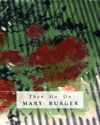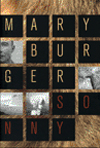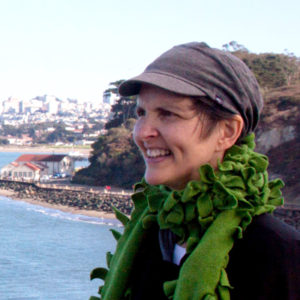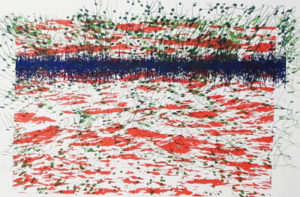The art of poetics begins with the intersection of the visual and the unseen. Word gives way to image, image to thought, thought to inspiration.
As communicators, human beings desire to bring value to the exchange—something ambiguous in the visual art world, value. What holds meaning for one may not for another, and what inspires is highly subjective.
More than value, we search for meaning. Who are we? To what do we devote attention? On what do we spend our time?
The idea of categories amongst thought makes experience easily interpretable. But what of the things that meet and mingle? Where does communication end and poetry begin? How is experience cataloged as “art”?
Writer, visual artist, and environmental designer, Mary Burger is interested in cross-genrewriting that merges aspects of poetry, essay, and fiction. Her books include Then Go On (Litmus Press, 2012), a collection of lyric prose pieces, Sonny (Leon Works, 2005), a novella on the Trinity bomb test, and A Partial Handbook for Navigators (Interbirth Books, 2008), writings about geography and social space.
In this post, we’ll learn a bit about Mary’s approach to writing and visual art, and the pursuit of intersecting questions we call “experience.”
When you first approach a new work, what freedoms do you give yourself to explore with words?
“New pieces well up from any number of places. I don’t put any restrictions on myself in exploring new pieces. If a piece seems like it will keep going (many don’t!), I try to have a sense of its shape or motivation (which might, after the fact, be described as form and content.) But those conceptions always change as a piece evolves. For a piece to do anything interesting, I have to be in a state of continual discovery and redefinition.”
Your knowledge of literary criticism is one of your strengths as an editor, publisher—and also a writer. What, in your opinion, makes good writing? What elements of literary criticism do you employ when writing your own work and when reading others’ work?
“For me good writing is anything that allows me as a reader to be in a state of discovery—the same state I aspire to as a writer.”
Of your completed works, which do you feel is your greatest accomplishment and why?
“Two stock answers: no one can choose among their own children! And, my newest work is always my favorite!
And a third thought: on some level everything I write is part of one lifelong investigation, so in that sense it’s all one long, varied work.”
How do you know when a poem, chapbook, or other piece of writing is “done”? (Is writing ever “done”?)
“There’s a combination of excitement and satisfaction when the work feels fresh and not over-worked.”
In an interview with Angel Dominquez, you mentioned that landscape architecture and design is “a time-based medium on the scale of seasons and years and generations and epochs.” How do you think this intersects with writing, and particularly poetry? How do you think that landscape architecture is like writing?
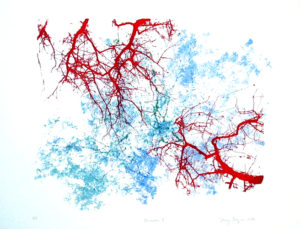

“Landscape architecture is like writing only in metaphorical or analogous ways. Working with landscape involves understanding contexts, processes, consequences, ecology, economy, politics, etc—all terms that we can apply to writing, but building a park and writing a book are pretty different. Making parallels between these activities helps us understand our assumptions about landscape, nature, or ecology, and helps us see the conceptual frameworks we use as writers. But I think it’s important not to blur the definitions too much.”
You also have stated that you believe “soil has narrative, history, timespan.” What do you mean by this statement? In what ways do you feel this statement hints at a political context? Additionally, how does landscape architecture and urban design inform our daily experiences?
“We—people generally interested in the future of life—are starting to understand what soil scientists have long known: soil is not inert, it’s a living ecosystem. Like air and water, soil is affected by human activity. If we want soil to remain viable for sustaining life, we have to pay attention to its processes.
Entire professions are devoted to exploring how landscape or urban design inform our experiences—I’ll simply say I’ve always been interested in understanding the stories of the places around me, how they came to be the way they are.”
You mention that as a writer, you are always immersed in research. How does research inform your writing and how do you balance the time between research and writing?
“Writing for me is a process of pursuing questions I’m interested in. Reading and writing go hand-in-hand in that process, of posing questions, exploring them, and finding new questions.”
Your current project Red Dust Tangle also looks at environment as experience and how we find our place in that environment. I’m intrigued by the passage:
“In the way that the flat, regular street grid accommodates movement equally in any direction, the houses, built square to the edges of the building envelope, made the streets seem like landscapes without mysteries. But the pervasive alleyways made a nameless second grid that shadowed every street and harbored what couldn’t fit in the named places.
A shadow is a ruin of the original. The clean edges reappear as a monstrosity, as an alien erupts from within. It was the figure-ground battle, one always struggling to overtake the other.”
What do you hope this passage evokes for readers? What message are you conveying about environment, experience and the intersection of these things?
“For me, these lines are about looking for relationships between the frankly explicable and the mysterious or the elusive. The built, spatial world is the material setting where experience takes place. We ascribe meaning to it as it shapes us.”
This work also includes images of the labyrinth, compartmentalization, passageways, order, and similar structural elements. What comments are being made about the urban infrastructure in this work? What does it indirectly say about the natural environment? How is this imagery used as a metaphor for something deeper?
“I got interested in the labyrinth as a place of intentional obfuscation. Generally, the conundrums or problems we run into in life don’t have specific authors or solutions. A labyrinth implies a designer. In this narrative, I think the labyrinth may be about the ways that we construe our own agency as we encounter the various challenges and opportunities of living. The urban scene, the environment are…contexts for living.”
When you hear the phrase “everything is connected” what do you think about? How do you think that the phrase “everything is connected” relates to the craft of writing? Art? Landscape architecture or other?
“I think of Juliana Spahr’s book This Connection of Everyone With Lungs. Also I think of what I know about interspecies dependency, which is basically the story of all life. Anything made—writing, art, design—comes out of a specific context, and the meaning of anything rests on how we understand its relationship to context.”
If you’d like to learn more about Mary and her visual art and written work, you can visit her website. Her books are available through Small Press Distribution.
